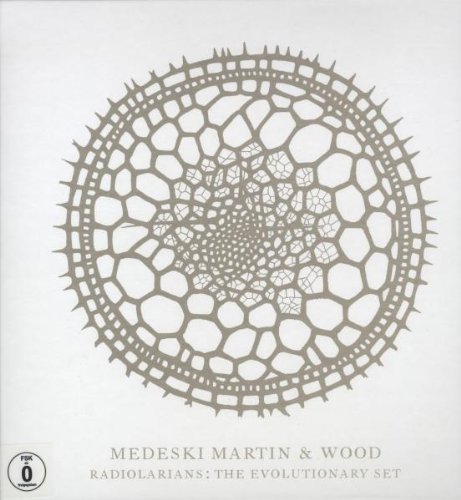Esbjorn Svensson Trio: Leukocyte (2008)
Medeski Martin & Wood: Radiolarians (I–III) (2008/2009)
by Marshall Bowden
Reinvention is the name of the game in music, at least in popular forms of music since the 1960s. Beginning with the innovations of The Beatles it became largely undesirable, if not impossible, for a pop or rock band to merely stake out a territory and continue to occupy it in perpetuity. There are exceptions—the Doors, metal bands like Black Sabbath and AC/DC, The Ramones—but overall failure to innovate generally leads to critical, and eventually popular, demise. That has been less true of jazz musicians until quite recently. True, major innovators like Charlie Parker and John Coltrane made it very difficult for new jazz musicians not to take their work as a starting point, but overall the idea of jazz musician as journeyman has provided for many lengthy careers playing in much the same style.
In fact, a musician who was overly innovative was sometimes suspect to jazz listeners. Take, for example, Booker Ervin, an exciting tenor saxophonist who is generally thought to be relegated to jazz music’s back pages because he was neither fish nor fowl. In his updated liner notes to the reissue of Ervin’s album The Freedom Book, critic Neil Tesser writes: “Ervin’s inclusive approach to jazz—blending the Texas tenor tradition and the new ideas swirling around after the emergence of Ornette Coleman and the evolution of John Colrane—would be highly prized today, when audiences and critics delight in such a portmanteau approach. But in the ionically charged and icon-rich Sixties, musicians and listeners often chose to take sides.” In short, a musician like Ervin was judged too modern for traditional jazz audiences, and too traditional for more experimental ones.

The sixties culminated in the advancement of both fusion and the free jazz avant-garde. At that time, musicians who did not belong to one or the other group were frequently judged to be part of yesterday’s jazz, not the current scene. That led, as it often does, to a backlash. The Young Lions sought to erase the excesses of fusion and free jazz and the incursion of what they saw as European elements into the music. But the proverbial cat was already out of the bag, and it seems unthinkable that listeners would go back to listening to jazz as though more than a decade of its development had never happened. Sure enough, the 1990s and the period since the turn of the century have seen the reemergence of innovation and reinvention as highly prized elements among jazz musicians.
Two cases in point are the 2008/2009 releases by the groups EST (Esbjorn Svensson Trio) and Medeski Martin and Wood (MMW). Both groups were fairly innovative in their approaches to jazz and improvisational music, and both have found ways to reinvent themselves with these most recent (sadly in the case of EST. their last) releases.
EST’s Leukocyte is a departure from the group’s last couple of recordings in which they largely filled in and perfected their overall approach to the music—lyrical, often romantic, at times rhythmically driven, and occasionally somewhat disturbing. They utilized some effects, particularly bassist Dan Berglund, but the music felt very organic.
In a 2006 interview, Svensson said
“I think music is a way of being, it’s like being kind of a god, to create a universe, to create time, to create the stars, and to create an end.”
Given that philosophy it is not surprising that he should move farther away from the conventions of both jazz and more mainstream popular music to create a sound, a universe, that is very much his own. There are familiar elements, to be sure, but there is a lot here that sounds like nothing this group has ever recorded, or attempted, before. The group has always utilized post-production manipulation of sound on their recordings, but here they utilize electronic and manipulated sounds in a manner suggestive, at times, of CAN or Radiohead. There are sounds that take things into the realm of industrial and metal grunge, and there is the delicate beauty so often found on EST’s recordings.
The album was completed and delivered before Svensson’s untimely death , so it was definitely meant to be the next missive from the band. As is always the case when a group moves forward, some fans are delighted and others are less than thrilled with the new developments.
Svensson’s listeners probably tended to be more adventurous than average, but still there are those who could have listened to Tuesday Wonderland and Seven Days of Falling repeated ad nauseum. Leukocyte is a profound sea change from this band, indicative of the direction they may well have continued to pursue had Svensson survived, and ultimately the album will probably be remembered well. The point is, the group felt compelled to move along and try something new. And it seems likely as well that the album would prove a dividing line between the group’s past and its future, as well as between two different groups of listeners. As it is, it’s an intriguing swan song and helps place this group in its proper place in modern jazz history.
Medeski Martin and Wood did things guerilla-style on their series of three Radiolarians recordings. Instead of composing and recording new music and then taking it out on the road, the group composed skeletal new compositions, then embarked on a tour to play and work the new material out on the road before finally going into a studio and recording it.
The music on these recordings isn’t generally the kind of radical departure for MMW that EST undertook on Leukocyte. They move through a series of different sounds and styles, often emphasized with Medeski’s acoustic piano work. He plays melodica on the track “Muchas Gracias,” but other tracks emphasize a bass and drum attack that is more rock and roll in nature. “Professor Nohair” plays with a New Orleans style that’s slightly quirky. And for the hard core MMW groove aficionados there’s “Free Go Lily” complete with phat clavinet work.

The innovation here is not the sound or the music itself, but in the way it is being composed, performed, recorded, and released. Releasing the albums themselves on their Indirecto label means they can do a project like this , which will result in three releases in a short period of time, still play live and perform new material, and realize a profit on the recordings and tours because there is no major label controlling it. The group has long been popular on the jam band circuit, and they realize that the public’s appetite for new music by their favorite musical groups far outstrips the ability of the major label-fueled traditional music industry to feed it.
As in everything from computer software to food, music listeners (‘consumers’ in the old parlance) want more choice. Creative musicians are in a position to deliver much more music than can be accommodated by major label constraints, including budget and creative constraints. This is clearly demonstrated by the massive amount of tape Miles Davis racked up in his period from 1968-1975 at Columbia Records. Davis was in a highly creative phase and was constantly retooling his sound and groups and recording everything as the raw material from which he and Teo Macero mined one classic album after another.
Computers, music software, the internet, iTunes, and the advent of the digital format as the preferred delivery format for music (despite its drawbacks—but hey, the industry went for 8-tracks, too) have made it easy to release everything. Despite the real drawbacks, the digital format allows for the fastest transfer of music from performer to listener and is highly convenient. Storage, too, becomes a relative non-issue with the ready availability of cheap storage space. When you move, it’s easier to move a couple of hard drives than a record, or even a CD, collection.
It’s arguable that with the release of practically every note a musician ever plays, one is introducing a large amount of mediocre (to say nothing of the outright bad) music into the musical marketplace and without any filter whatsoever. That may be true, but first, there is a market for this music and a loyal, if small, group of fans who will devour it all. Additionally, much of the music that would otherwise go unreleased is good and well worth hearing. Sometimes it provides a link between different phases of an artist’s career.
Jazz and popular artists have learned to innovate both out of sheer creativity and for survival. Neither route guarantees artistic or commercial success (and neither one makes it a de facto impossibility, either). EST was ready to do something very different musically, and began to search for a new language of sound for the group to work with. MMW decided to try a new approach to recording and releasing their music, taking charge of the process from start to finish. Both approaches produce music that may or may not stand alongside the artist’s best output—time will tell. But both produce music that is vital and stretches the boundaries of its performers and its listeners. That can’t be bad.